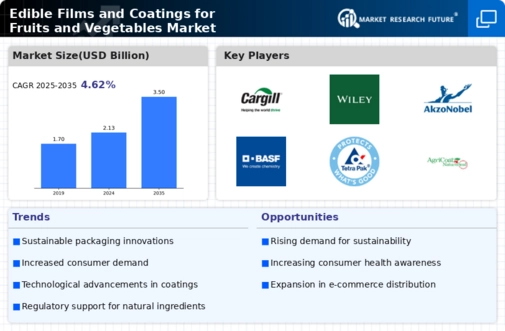Health and Wellness Trends
The rising health consciousness among consumers is a significant driver for the Edible Films and Coatings for Fruits and Vegetables Market. As individuals become more aware of the nutritional value of their food, there is a growing demand for products that not only preserve freshness but also enhance the nutritional profile of fruits and vegetables. Edible coatings can be enriched with vitamins, minerals, and antioxidants, appealing to health-conscious consumers. This trend is reflected in market data, which indicates that the demand for functional food products is on the rise, with projections suggesting a market size increase of approximately 10% annually. This shift towards healthier eating habits is likely to propel the growth of edible films and coatings.
Sustainability Initiatives
The increasing emphasis on sustainability is a pivotal driver for the Edible Films and Coatings for Fruits and Vegetables Market. Consumers and manufacturers alike are becoming more aware of the environmental impact of packaging materials. Edible films and coatings, often derived from natural sources, offer a biodegradable alternative to traditional plastic packaging. This shift towards eco-friendly solutions is not merely a trend; it is becoming a necessity as regulatory bodies impose stricter guidelines on waste management. The market for edible coatings is projected to grow significantly, with estimates suggesting a compound annual growth rate of over 5% in the coming years. This growth reflects a broader commitment to reducing carbon footprints and promoting sustainable agricultural practices.
Technological Advancements
Technological advancements play a crucial role in shaping the Edible Films and Coatings for Fruits and Vegetables Market. Innovations in material science have led to the development of more effective and versatile edible coatings that enhance the shelf life and quality of fruits and vegetables. For instance, the incorporation of nanotechnology has improved the barrier properties of these films, making them more effective against moisture and gas exchange. This not only preserves the freshness of produce but also reduces food waste, which is a growing concern globally. The market is witnessing a surge in research and development activities aimed at optimizing these technologies, with investments in this sector expected to rise significantly in the next few years.
Regulatory Support and Standards
Regulatory support and the establishment of standards are increasingly influencing the Edible Films and Coatings for Fruits and Vegetables Market. Governments and international bodies are recognizing the potential of edible coatings in enhancing food safety and reducing waste. As a result, there is a growing framework of regulations that promote the use of natural and safe materials in food packaging. This regulatory environment not only encourages innovation but also instills consumer confidence in edible films and coatings. The market is likely to benefit from these supportive policies, as they pave the way for broader adoption and integration of edible coatings in the food supply chain, ultimately enhancing food quality and safety.
Consumer Demand for Fresh Produce
The increasing consumer demand for fresh and minimally processed produce is a key driver for the Edible Films and Coatings for Fruits and Vegetables Market. As consumers seek convenience and quality, the need for effective preservation methods becomes paramount. Edible coatings serve as a barrier to moisture loss and microbial contamination, thereby extending the shelf life of fruits and vegetables. Market analysis indicates that the fresh produce sector is experiencing robust growth, with sales projected to reach unprecedented levels in the next few years. This trend underscores the importance of innovative preservation techniques, as consumers are willing to pay a premium for products that maintain their freshness and quality.
























Leave a Comment